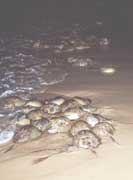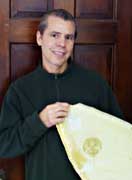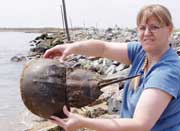|
|
 |
|||||||||
|
Volume 13, Issue 25 ~ June 23 -29 , 2005
|
||||||||||
 Trailing the Ancient Mariner Trailing the Ancient Marinerstory & photos by Edward Engel He may not be a beautiful swimmer — or at first glance, beautiful at all — but the American horseshoe crab, Limulus Polyphemus, becomes more remarkable the more you learn about him. Over his millions of years on Earth, the horseshoe crab has been misunderstood. Consider his moniker. In Greek mythology, Polyphemus was a giant one-eyed monster, a Cyclops. While the horseshoe crab’s alien appearance may initially be fearsome, he is a harmless creature who pays little attention to humans. The cluster of light-sensing organs on the forefront of his shell is certainly Cyclops-like, yet the horseshoe crab actually has 10 eyes, including the largest photoreceptors in the animal kingdom. When we stop to consider the horseshoe crab, perhaps it is we who are cyclopean. If we’re aware of them at all, we tend to look at horseshoe crabs in one way. As bait. As nuisances. Or as curiosities. But there are at least as many ways to look at horseshoe crabs as horseshoe crabs have of looking at the world. We learned that despite the many variables affecting when horseshoe crabs will come ashore to mate, Limulus Polyphemus is somewhat predictable. They are especially fond of doing their beach waltz around the high tides of a full or new moon. But the Weather Channel was predicting breezy days ahead, and horseshoes tend to be no-shows when wind and waves are too strong. So we had some doubts about our chances of seeing platoons of these army-helmeted arthropods frolicking in the sand.
You can tell you’ve found Glenn Gauvry’s office in Lewes, Del., by the horseshoe crab knocker on the door. Inside hang freestyle Sumi-e brush paintings of horseshoe crabs and shrimp and a couple of Jurassic-era fossils of juvenile horseshoes. Of course, horseshoe crabs are themselves living fossils. Gauvry calls them “ancient mariners.” This former Philadelphian studied industrial design, ran a custom furniture firm and burnt out from the travails of trying to rescue wildlife from oil spills. When Gauvry started Ecological Research and Development Group a decade ago, it was primarily as a consulting organization for oil spill contingencies. But as he became intrigued by the horseshoe crab, he noticed it had no group acting as its advocate. His company morphed into the only nonprofit devoted to the four species of horseshoe crabs around the world. “As an industrial designer, I think they’re a fascinating design,” Gauvry says. “They’ve got sensory organs in the millions. They can sense current, salinity, pollution. They’ve got 10 eyes that can synchronize to the lunar cycles of the moon and UV sensors that can tell when they’re getting into shallower water. They made it through 250 million years, with five great extinctions. The one thing that’s given them a rough time is us.” Gauvry lays much of the blame for the horseshoe crab’s decline on coastal development and loss of habitat. But the culprit cited most often by birding groups and researchers is watermen’s use of the crabs for conch and eel bait. The latest controversy in the horseshoe crab saga revolves around the steep drop in the population of the red knot — a rust-breasted, dove-sized shorebird — and whether the horseshoe crab’s decline plays a primary role. From mid-May to early June, red knots, ruddy turnstones, semipalmated sandpipers and other shorebirds fly north from South America to the Arctic, stopping along the Delaware Bay to feast on horseshoe crab eggs, perhaps doubling their weight before continuing their Arctic migration. These days, they’re finding far fewer eggs when they arrive, and the red knot’s numbers have declined from around 100,000 two decades ago to 16,000. A group of environmental organizations has been pressing for a horseshoe crab moratorium, and on June 9 New Jersey suspended harvesting in Delaware Bay for two weeks. Birding organizations say that the 2005 crab egg-density count is the lowest recorded; they claim that the red knot could be extinct by 2010.
Meanwhile, Delaware Bay watermen have weathered a number of restrictions on horseshoe crab harvests in the last several years, following decades of overharvesting. They’re not happy about the prospects of more caps, and they argue that the crab population is stable, if not increasing. At Bowers Beach, Del., commercial fisherman Frank ‘Thumper’ Eicherly IV, unloads his schooner, Maggie Myers, after a day of fishing conch. Eicherly says the handpicking regulations in Delaware have become so cumbersome, and the birding issues so contentious, he has stopped gleaning horseshoe crabs from the beach and buys the bait instead. “I used to be able to get if off my beach right here,” he says. “I’d tie my boat [a runabout] on to my belt buckle and walk down the beach and just throw a couple of horseshoe crabs in the boat, and I’d get my supply for like three days. Do that all summer.” Horseshoe-lover Gauvry acknowledges that the red knot population is shrinking, but he says the reasons are unclear. Horseshoe crabs’ and shorebirds’ schedules sometimes just don’t mesh, he says. For example, the cold and rainy 2005 season delayed the crab’s arrival. Thus a lot of the eggs won’t be laid until after the birds have already headed north. He’s also concerned that more restrictions on horseshoe crab harvesting might do more long-term harm than good for the crabs by alienating fishing communities against them. Because the Delaware Bay is not the only place in the world where crabs are commercially harvested, a moratorium there could lead to more crabs being taken elsewhere. The biomedical industry, for instance, could turn to China “where there are no regulations.” Gauvry is something of an oddity in the environmental movement, a conservationist who has issues with regulation. He believes in seeking a balance among interests. The way to push crab conservation is by turning it, he says, “into something that’s cool.” With the help of Frank Eicherly, Gauvry pioneered the use of bags that cut the amount of horseshoe crabs needed for bait by half. The bags are simple enclosures of plastic mesh that keep undesirable creatures away from the crab bait, resulting in higher whelk catches. Garvey’s group has distributed some 12,000 of these bags free. Another of the organization’s efforts is its Just Flip ’Em campaign to get residents of bay communities to set overturned crabs back on their feet. It’s a win-win situation: The horseshoes get to live, and the residents don’t have crabs rotting on their beach. Ecological Research and Development Group campaigned to declare four Delaware shore towns as horseshoe crab sanctuaries, in effect making it illegal for crabs to be harvested there. Rather than having the sanctuary status imposed by some governmental body, however, Gauvry went door to door among residents to get support for the havens.
The first sanctuary town is Broadkill Beach, a curious mix of modest old beach houses and modern manses. Lois Rehkamp, who has run the Broadkill Store for 20 years, remembers what the locals used to think of the crabs. “Back then, they were piled a couple of feet high. They stank. They attracted flies.” She points to T-shirts and tote bags in her store plugging Broadkill’s connection with the Limulus. “Now, they get a lot more respect. They’re not a hassle; there aren’t so many around.” Will residents feel that way if the horseshoe crab makes a comeback? Horseshoe surveys in Delaware over the last few years suggest that the population has stabilized here. “Ultimately there’s not going to be much restricting the horseshoe crab population’s rebound,” says Gauvry. “If we’re successful building coastal sanctuaries, habitat will be assured. So if the population gets larger and larger and it starts looking like it did when the old timers complained, the challenge for us is this: Can we change the minds of the inhabitants along the horseshoe crab’s spawning habitat to embrace this animal as it rebounds?” Primehook National Wildlife Refuge — Jack Schulze, a refuge volunteer, is manning the desk when Isaku Higa enters with wife Yuko and daughter Chieri, 9. “Do you know where to go to find the horseshoe crabs?” he asks. Chieri is writing a school paper on Limulus Polyphemus. The family, originally from Japan, wants to see the crabs, shorebirds or no shorebirds. “In Japan, it is so rare to see them,” explains Higa. Schulze recalls his experience with the horseshoe crab at Bowers Beach when he first moved to the shore. “I had three kids with me and they were saying, ‘Ooh, it stinks!’ At that time it was hard to walk around without stepping over them. Now, it’s like: ‘Where do I go to see the horseshoe crabs?’ ’’ South Bowers Beach, Delaware — South Bowers is actually across a channel and a slew of long back roads away from Bowers Beach, but both towns have this in common: They are considered horseshoe crab hotspots. A few hours ago, we drove the lone road into town. When we come back — for our second horseshoe count of the week — it’s dark and the tide is flowing across the road and through the marsh beyond us. We’re waiting with Dick Slemons, an Ohio State University veterinary professor. “What’ll it take to float a canoe down here?” he quips. Moments later, sisters Faith and Leah Zerbe pull up with a pair of kayaks atop their roof. A father and daughter show up, then Bill Hall, our survey leader and a University of Delaware marine education specialist who gave a tour of South Bowers horseshoes to the BBC the previous night. “This is a pretty high tide,” Hall says. “Considering there’s no wind, it’s a very high tide.” We attach red gels to our headlamps so as not to affect the crabs’ vision and circadian rhythms. A flooded dirt road is our path to the beach. There, the waves are washing over the sand and into the marsh on the far side. The water is calf deep, and our feet sink into the sand. We’re amongst the crabs, and walking takes concentration to avoid stepping on a moving carapace or swinging telson. The crabs sense the tides pulled high by the full moon, though clouds blanket any light from the sky. As the crabs wash into the marsh, Sue’s headlamp spots a crab with a round, white tag affixed to his shell. The group halts, and Hall stops to explain that these tags help researchers determine the movement of the crab over the seasons. The crabs glisten all around us in the red light of our headlamps. As we try to stand motionless in the waves, the crabs scuttle across our feet. With receding tide, the count begins at a business-like pace. Manning the quadrat, Hall counts while Sue records the numbers and others measure. For 100 repetitions, he walks to the designated measurement, lays the frame down and counts the crabs inside, often reaching down on his hands and knees to gently check their gender and number. Hall calls out: “10 males, no females!”, and Sue writes “10” and “0.” “Eight and one!” “Nine and three!” Meanwhile, those who aren’t measuring are flipping crabs over. My technique is to tip the crabs with the edge of my foot until they (hopefully) plop down. The other volunteers are more dexterous. Faith is quick and graceful as she lifts the crabs by the edge of their shells and places them down in the surf. Sometimes a mass of crabs is gathered just outside the borders of the quadrat. But it’s only what’s inside the frame that counts. Hall yells out more numbers. We return to our cars around midnight, wet and tired, but happy that we’d had this beguiling experience. And just as happy that the spring tide has not claimed the one road out of town.
Port Mahon, Delaware — There’s not much to see anymore in Port Mahon. The lighthouse burned down 20 years ago. The fishing shacks and shucking houses are gone, too. But come round the time horseshoe crabs are mating, and birders-in-the-know will be hoisting binoculars and pointing sighting scopes to spot sanderlings, turnstones and the rare red knot by this curve of shoreline. This afternoon, there’s a line of birders parked by the road looking up at the skies. Sue and I are here too, but we’re looking down — at a pipeline that’s said to carry jet fuel for nearby Dover Air Force Base. The pipeline runs above a marsh. Underneath it, horseshoes are crawling and laying eggs beneath a blanket of foamy, tannish muck of unknown origin. This doesn’t look like a good nesting ground; we have an uneasy feeling for them. Things aren’t much better across the road, where horseshoes are spawning on the rocky bayside. Crabs are stuck in the riprap, their clawed feet flailing to get back into the surf before the tide recedes farther. Some we remove easily; others are a struggle. One male is wedged in solid with a large rock leaning on the back of his shell. Sue heaves the rock forward, calling for me to help. I scoop the crab out just before Sue lets the rock fall back into place. We rescue perhaps 50. As we turn to leave, I spot another length of rocks, extending a half-mile or so north. Even if we worked at it all day, when the tide came back in, more crabs would get stuck. “It’s an endless task,” she sighs. “Truly Sisyphean.” Later that day, while searching the sand for elusive lines of the blue-green eggs that wash up with the tide, I’m reminded of a story Gauvry told us. A year ago, he met a woman who had lived for years on Primehook Beach and had never seen horseshoe eggs in the sand. “So I showed her, and she was really excited by that.” Then, Gauvry found one egg whose outer green layer had broken off: “It was like a tiny snow globe, and you could see the horseshoe crab swimming around in it. She was impressed and she said, ‘What’s going to happen to it?’ And I said, ‘Well, unfortunately, because it’s on the surface, it’s going to die.’ Then she wanted to know if it could be kept alive. I said, ‘Well, yeah, if you dug down around six inches and you put it down there.’ Then she said: ‘Well, what about all the other ones?” Gauvry smiled. “There are probably a million of them down there. You gotta draw the line somewhere.” Slaughter Beach, Delaware — We have one last horseshoe crab count left, and it’s the one we’ve been looking forward to most. When the crabs are mating at Slaughter Beach, there may not be a better stretch of sand in the world to see them. Last year, an estimated 259,000 crabs showed up at Slaughter on the 12 nights of the spawning survey there. That compares to 63,000 at South Bowers Beach. It was work to avoid stepping on the crabs at South Bowers; we could only imagine what Slaughter would be like. This was a town so proud of its association with Limulus Polyphemus that an image of one graces its welcome sign. The count was set to begin a little before midnight, and we could foresee the hordes of suitors clasping on to their partners, the click-clack of shells, the thousands of eyes peering out from the shallows. It was a dark and stormy night at Slaughter Beach. Which may be good for some stories, but not for this one. “With the wind and tide and it being as cold as it is, Ed, we’ve decided to cancel.” The call came from Bill Rafter, our contact person at the Slaughter Beach Mini Market. On the Delaware Bay, we couldn’t see all the way across to New Jersey, but from our beach house there was always a steady queue of ships in view. Now that we’d returned to the Chesapeake, we could glimpse the far shore, and the shipping lanes were less traveled. We decided to visit our community beach at the new moon high tide to try our luck at seeing horseshoe crabs mating in more modest numbers. In previous nocturnal visits here, we’d glimpsed several couples nesting in the warm sand. At 5am the sun was just rising. The Bay was as glassy as we’ve seen it. Pale rose and gold lit the clouds in the east, and a few stars still shone in the western sky. We walked a half mile. We saw dog tracks. Deer tracks. A heron flying up the shore. But the only suggestion of horseshoe crabs was a lone empty shell that could have been there for weeks. That was okay; we would return. Eventually, the Chesapeake has always rewarded us. At home, Sue brought out Henry Beston’s The Outermost House, a book he wrote while living on the beach at Cape Cod. “This is what I was trying to remember all week,” she said. It did seem to fit them perfectly: “In a world older and more complete than ours, they move finished and complete, gifted with extensions of the senses we have lost or never attained, living by voices we shall never hear.”
|
||||||||||
|
|
||||||||||
|
© COPYRIGHT 2004 by New Bay Enterprises, Inc. All rights reserved. |

 Bacchanalia on the Beach
Bacchanalia on the Beach



 About the Author
About the Author